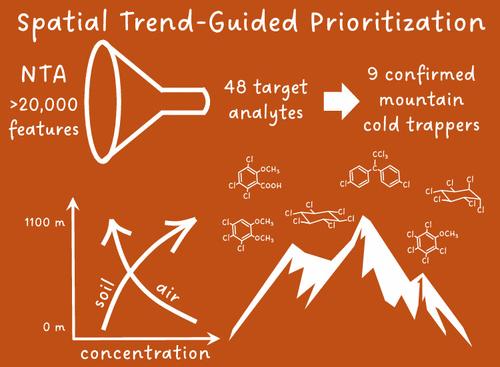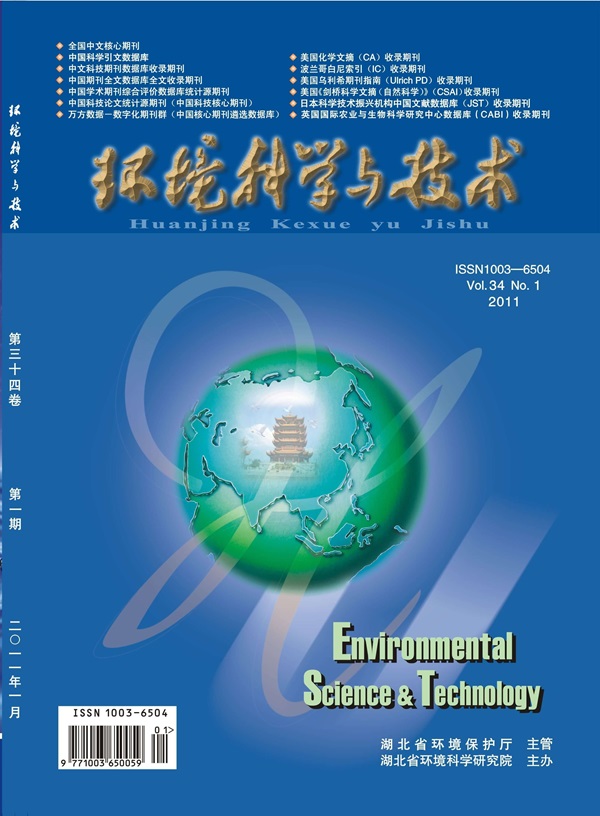Prioritizing Chemical Features in Non-targeted Analysis through Spatial Trend Analysis: Application to the Identification of Organic Chemicals Subject to Mountain Cold-Trapping
IF 11.3
1区 环境科学与生态学
Q1 ENGINEERING, ENVIRONMENTAL
引用次数: 0
Abstract
One of the challenges arising during non-targeted analysis (NTA) is that the number of detected chemical features is generally too large for detailed processing and interpretation. Here, we illustrate how the analysis of spatial trends in peak intensities can be an effective tool to prioritize chemical features in NTA. Specifically, features detected by gas chromatography and high-resolution mass spectrometry in soil and air samples, collected along an altitudinal transect on an urban mountain in Canada, were successfully grouped into different categories based on spatial trends with site altitude. The motivation was to identify features whose abundance increases in soil with increasing elevation, as the ability for amplification at higher elevations could characterize contaminants of concern to mountain ecosystems. Potential matching candidates were first selected by comparing empirically detected accurate masses and isotope distributions of chemical features with those in chemical databases. These potential candidates were then ranked by comparing MSMS spectra with fragments predicted in silico. Several highly ranked matches, as well as structurally related compounds, which were largely halogenated methoxylated benzenes and organochlorine pesticides, were then subjected to targeted analysis with analytical standards. Several of these compounds, including pentachloroanisole, tricamba, and 3,4,5-trichloroveratrole, were identified as having spatial patterns consistent with mountain cold-trapping, as evidenced by organic carbon-normalized soil concentrations that show a significant increase with elevation. Our study clearly demonstrated that spatial trend analysis holds considerable promise as a tool to guide chemical identification and prioritization during NTA.

基于空间趋势分析的非定向分析中化学特征优先排序:在山地冷捕集有机化学品识别中的应用
在非目标分析(NTA)中出现的挑战之一是,检测到的化学特征数量通常太大,无法进行详细的处理和解释。在这里,我们说明了如何分析峰值强度的空间趋势可以成为优先考虑NTA化学特征的有效工具。具体而言,通过气相色谱法和高分辨率质谱法在加拿大城市山区沿海拔样带收集的土壤和空气样本中检测到的特征,成功地根据地点海拔的空间趋势分为不同的类别。其动机是确定土壤中丰度随海拔升高而增加的特征,因为在海拔较高的地方,丰度增加的能力可以表征与山地生态系统有关的污染物的特征。首先通过将经验检测到的精确质量和同位素分布与化学数据库中的化学特征进行比较,选择潜在的匹配候选者。然后将MSMS光谱与硅预测的片段进行比较,对这些潜在的候选者进行排序。然后用分析标准对一些高排名的匹配物以及结构相关的化合物(主要是卤化甲氧基苯和有机氯农药)进行有针对性的分析。其中的几种化合物,包括五氯苯甲唑、三氯苯甲巴和3,4,5-三氯氟咯,被确定为具有与山地冷捕获一致的空间格局,这一点可以通过有机碳标准化土壤浓度随海拔升高而显著增加来证明。我们的研究清楚地表明,空间趋势分析作为指导NTA期间化学物质识别和优先排序的工具具有相当大的前景。
本文章由计算机程序翻译,如有差异,请以英文原文为准。
求助全文
约1分钟内获得全文
求助全文
来源期刊

环境科学与技术
环境科学-工程:环境
CiteScore
17.50
自引率
9.60%
发文量
12359
审稿时长
2.8 months
期刊介绍:
Environmental Science & Technology (ES&T) is a co-sponsored academic and technical magazine by the Hubei Provincial Environmental Protection Bureau and the Hubei Provincial Academy of Environmental Sciences.
Environmental Science & Technology (ES&T) holds the status of Chinese core journals, scientific papers source journals of China, Chinese Science Citation Database source journals, and Chinese Academic Journal Comprehensive Evaluation Database source journals. This publication focuses on the academic field of environmental protection, featuring articles related to environmental protection and technical advancements.
 求助内容:
求助内容: 应助结果提醒方式:
应助结果提醒方式:


